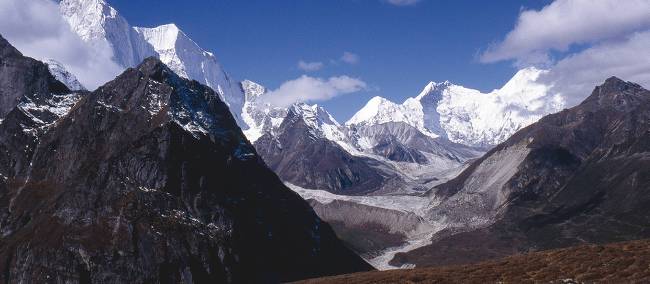
Views of Everest and the Kangshung Glacier, Tibet | Alan and Julie Marshall
Tibet has so much to offer travellers seeking the paths less travelled, with vast high altitude landscapes, untouristed trails, colourful festivals and a fascinating ancient culture to discover.
There is no denying the profound challenges that Tibet has encountered over the years. Yet despite these struggles, the strength and tenacity of the Tibetan people prevails.
Tibet is a deeply religious land with an ancient culture that is still preserved today. Visiting the sacred places where the Tibetan people worship is inspiring. It is an experience that remains with those fortunate enough to visit for many years.
Whatever adventure you choose in Tibet, we are sure that you’ll fall in love with this spiritual, dramatic and inspiring autonomous region.
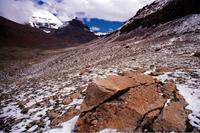
1. Tibet's Unique Landscape
Tibet’s phenomenal landscape is like no other place on Earth: rugged, remote and unforgettable. The vast Tibetan plateau contrasted against the snowcapped peaks of the world’s highest mountains will leave you in awe.
Tibet is often referred to as the ‘roof of the world’. This is because the majority of Tibet sits at an altitude around 4500m above sea level. The Tibetan plateau stretches for some 2000km from west to east, with many peaks on the border of Nepal soaring well above that. With the Himalaya to the south, the Karakoram to the west and the Kunlun to the north, you only have to turn your head to get another magnificent view of the mountains.
A highlight of travelling to Tibet is the memorable flight to Lhasa over the Himalayan range. With clear weather, the views of Everest, Lhotse, Cho Oyu, Makalu and countless other peaks stretching into the horizon are breathtaking.
Tibet is a superb trekking destination. The remarkable landscapes and Himalaya views are one of the greatest reasons to visit Tibet. As you trek the high passes and winding trails that are strewn with Buddhist prayer flags you’ll feel greatly inspired by this ancient land.
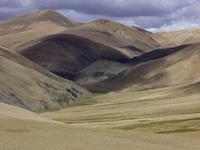
2. The Tibetan People and Culture
Experiencing the Tibetan culture is undoubtedly a highlight of visiting Tibet.
Tibetans are deeply religious people. Their devotion to Buddhism can be traced back to the earliest days of Buddhism’s introduction into Tibet, more than 1300 years ago. The profound influence of Buddhism for the Tibetan people is a highlight of any visit to Tibet.
Aside from a wide array of Buddhist gods and goddesses worhsipped by the Tibetan people, they also worship the mountains as living deities. All over Tibet you will spot pilgrims spinning prayer wheels and walking around temples, monasteries and mountains. This is always in a clockwise direction, whereas followers of the indigenous Tibetan religion, the Bon, walk around sacred sites in an anti-clockwise direction.
Despite the grandeur of the scenery, the most memorable experiences of Tibet are likely to come from moments you’ve shared with the locals. Whether it’s the yak-butter tea offered to you from a monk in a remote monastery or a spontaneous picnic with a herding family on the shores of a remote lake, you are bound to leave Tibet with a deeper insight and appreciation into their unique cultural identity.
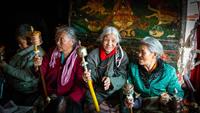
3. Festivals
There are over 100 festivals in Tibet that occur throughout the year. Experiencing a festival in Tibet is a unique way to get an insight into Tibetan Buddhism.
One of Tibet’s most significant festivals is the Saga Dawa festival held at Mount Kailash - one of the most sacred places in the Buddhist and Hindu religions.
At the Saga Dawa Festival many thousands of pilgrims throughout Tibet pay homage to Mount Kailash. The sacred mountain has long been regarded by Hindus and Buddhists as the Mythical Mount Meru, the cosmic centre of the universe from which all life flows.
Thousands of pilgrims will gather and pay homage to the mountain by performing a kora, or clockwise circumambulation of the base of the mountain. The trek lasts several days and crosses a 5800m pass.
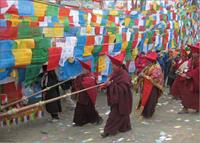
4. The Remarkable Monasteries
Ancient monasteries are scattered throughout Tibet and were the most significant social institutions of historical Tibet. With religion being extremely important to Tibetans, monasteries are centers of learning were monks and nuns are responsible for preserving and spreading Buddhist teachings.
Sadly over 6000 monasteries were destroyed during China’s Cultural Revolution. Since the 1980s some monasteries have rebuilt, with greater religious freedom being granted. Today, monks have returned to monasteries across Tibet and monastic education has continued.
Most monasteries and temples in Tibet extend a warm welcome to visitors and even in remote areas they will often offer places to stay the night. Some of the monasteries visited on our trips include Samye, Ganden and Jorkhang. Visiting a monastery in Tibet is a fascinating way to get an insight into the religion that has profoundly shaped Tibet today.
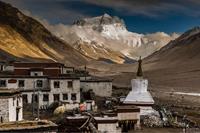
5. Travelling on the Friendship Highway
The journey on the Friendship Highway is an epic drive over 850km between Kathmandu and Lhasa. It is without doubt one of the most spectacular journeys in the world.
The border crossing between Nepal and Tibet was closed after it was damaged in the 2015 earthquake. However, no other section of the highway is damaged so it is still possible to drive through Tibet right up to Rongphu Monastery and Everest base camp.
The drive along the highway will take 2-3 days but is well worth it with spectacular scenery along the way. You’ll see special cultural monuments, as well as vast grasslands, the upper valley of Yarlung Tsangpo River and breathtaking Himalayan views.
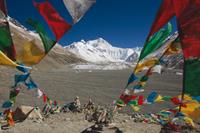
Want to see it for yourself? Explore our range of active adventures in Tibet.